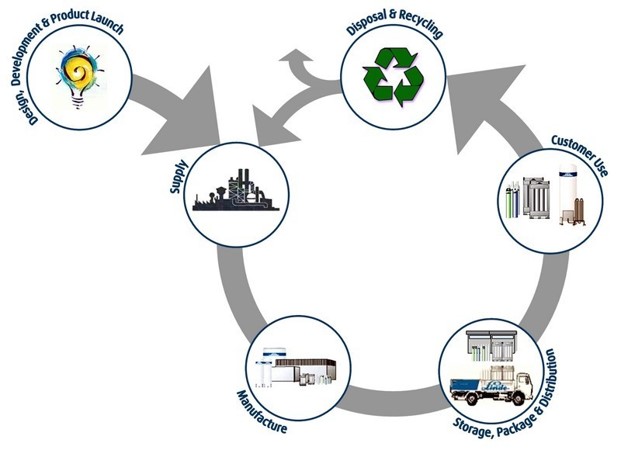Sustainable Development
Essential idea: Sustainable development is concerned with satisfying human needs for resources now and in the future without compromising the carrying capacity of the planet.
Designers utilize design approaches that support sustainable development across a variety of contexts. A holistic and systematic approach is needed at all stages of design development to satisfy all stakeholders. In order to develop sustainable products, designers must balance aesthetic, cost, social, cultural, energy, material, health and usability considerations.
Triple bottom line sustainability does not only focus on the profitability of an organization or product, but also the environmental and social benefit it can bring.
- Sustainability is the long-term maintenance of responsibility, which has environmental, economic and social dimensions. It is the capacity to endure and maintain.
- Sustainable Development meets the needs of the present without compromising the ability of future generations to meet their own needs.
Triple Bottom Line
The concept of the triple bottom line means that business success is no longer defined only by monetary gain but also by the impact an organization's activities have on society as a whole - Environmental, Economic, and Social.
- Social - Social sustainability is designing to develop goods and services for the enhancement of human well-being, maintaining cultural identity, empowerment of local communities, accessibility to resources and services, social and gender equity, and other topic subjects that are concerned with social factors.
- Environmental - Sustainable environmental practices: it is technically possible to deliver the same or equivalent goods and services with lower environmental impact while maintaining social and equity benefits.
- Economic - Economic development increases the GDP and spending power of people; may be hard to balance with environmental considerations. Sustainable economic development is necessary so that people are not demanding too much products that may perhaps be made in an unsustainable way. Economic considerations would be maintaining economic growth through the use of improving productivity as well as reducing resource use and reducing environmental impact.
Decoupling
Decoupling is a strategy for sustainability . Decoupling refers to disconnecting two trends so that one no longer depends on the other. Through the act of decoupling (using resources more productively and redesigning production systems), it is technically possible to deliver the same or equivalent goods and services with lower environmental impact while maintaining social and equity benefits.
| Decoupling Impacts and Resources |
- Breaking the link between "environmental bads" and "economic goods" - having rates of increasing wealth greater than the rates of increasing impacts, thus creating a more dire need to disconnect economic growth and environmental impact.
- Resource decoupling means getting more efficiency from the resources we use, so that we can spread the use of our finite resources out over a longer time frame.
- Impact decoupling means using processes that leave a smaller footprint on the ecosystem, so that our building and manufacturing do not harm the ecosystem. WE need a healthy ecosystem for our own survival.
International and National Laws
The use of international and national laws promotes sustainable development. Nations need to adhere to the treaties or laws usually through enforceable domestic legislation.
- International and national laws encourage companies to focus on something other than the shareholder value and financial performance
- Adopting a corporate strategy that has the support of the shareholders/stakeholders can be difficult to achieve - thus increasing the effectiveness of the implementation of laws.
- These international agreements could consist of efforts on how to tackle environmental issues and concerns; such as reducing greenhouse gasses, relying on public transport to reduce vehicle emissions, or pursuing renewable energy alternatives.
CASE STUDIES OF INTERNATIONAL LAW AND TREATIES
- The Earth Summit - Rio de Janeiro (1992)
- Kyoto Protocol (1997)
- The Copenhagen Accord (2009)
- Paris Agreement (2015)

Sustainability Reporting
Businesses produce sustainability reports for the interests of governments, manufacturers, and consumers. A sustainability report is a company report that focuses on four aspects of performance. Sustainability reporting is a vital step towards achieving a sustainable global economy.
- Economic
- Environmental
- Social
- Governance
Benefits to Governments:
Sustainability information can be used by governments to access the impact and contribution of business to the economy and to understand which issues are being tackled. It creates transparency; can help markets function more efficiently and indicate the health of the economy; and help drive progress by all organizations towards a smart, sustainable and inclusive growth.
Benefits to Manufacturers:
Organizations can use reporting to inform their risk analysis strategies and boost their business systems. A growing number of companies see sustainability reporting as a means to drive greater innovation through their businesses and products to create a competitive advantage in the market. It can reduce their compliance costs paid to the government.
- can use for manufacturing
- enhanced branding or reputation
- potential cost savings
Benefits to Consumers:
Builds trust. It reveals the company's contribution to a green economy. Consumers want to know whether a company is performing in a globally responsible manner from an environmental perspective and a social perspective. It can also provide the consumer with greater innovation thus providing choice of new products.
Product Stewardship

Product stewardship is a concept in which everyone is involved in the making, selling, buying, or handling equipment (products) takes responsibility for minimizing environmental impact of the equipment at all stages in their life cycle. Designers may need to respond to consumer pressure as more consumers become aware of resource issues and product labelling.
 |
| Process of product making |

No comments:
Post a Comment